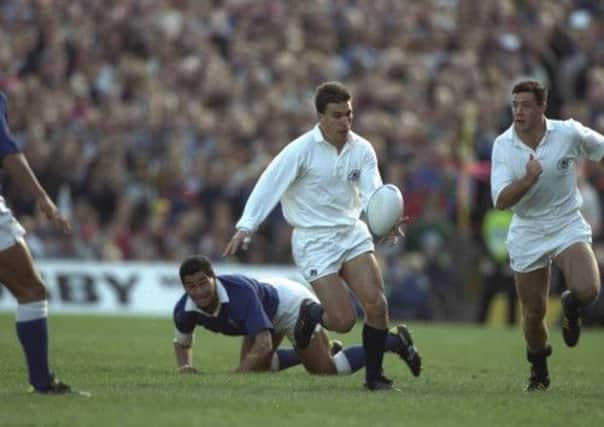Archive: Scotland 28 - 6 Western Samoa, 21 Oct 1991


The Samoans may have snuffed out the Welsh dragon and deserved raised glasses but ultimately they could only offer sprinkler resistance in the face of a Scottish conflagration. It means England will travel north to Murrayfield next Saturday with a place in the World Cup final at stake.
The tenor of Scotland’s performance was established in the opening minutes. Gavin Hastings, like an enraged bull, was triggered in the extra flanker role at the first two rucks, as Scotland swept from 22 to halfway. Scotland had suspected Samoan full-back, Anitelea Aiolupo, was a shade dodgy under the high ball and, sure enough, he was posted missing at the first. And at an early scrum, John Allan took the first of his two tightheads, the setpiece shelf which he was to adorn with umpteen ornaments, such was his industry in the loose. Allan was not alone in that second-phase category. As the Samoan flanker, Apolo Perelini, noted: “We knew of the experience of the Scottish back-row. As a schoolboy I watched them on TV, yet after facing them what can I say? I will always respect them. They were superb.”
Advertisement
Hide AdAdvertisement
Hide AdJohn Jeffrey, Derek White and Finlay Calder have 105 caps between them but rarely as a trio could they have exerted such influence on a game. Plaudits, too, for the sterling workrate of Chris Gray and Paul Burnell. The back row were the footsoldiers who enacted the strategy of coaches Ian McGeechan and Jim Telfer. All three are so self-effacing that they preferred to blether not about their role as principals but of that of the chorus (aka the crowd).
Scotland, believing that the Samoans would relish nothing more than the opportunity to tackle an isolated ball-carrier in open space, played the game very much around the fringes. “If you are a relatively static target, they quite enjoy that,” said McGeechan. “Our aim was to try to keep the ball moving and the target coming towards them.”
It was a ploy which would seem to have been ingrained in Gary Armstrong to such a degree that a beckoning three-man overlap could be ignored in the first half and in the second, a touch kick to the 22, preferred to initiating wide spread after Jeffrey’s tigerish drive.
McGeechan, in the briefest of comments, did not reckon Armstrong should have moved more ball, though the thought persists that in the semi-final against England he will have to.
Not that my sentiments should in any way detract from another Herculean performance by Armstrong. At the death, as Pat Lam, To’o Vaega and Frank Bunce threatened, it was Armstrong with two Samoans draped around his neck who made the clearance.
His priceless covering, too, once saved Tony Stanger’s blushes after Timo Tagaloa had decided it was time for Centurion tank manouevres.
Scotland’s rapid inter-passing was seen at its best in two movements. One was triggered by Calder in his own 22 and featured Craig Chalmers, Gavin Hastings and White, though the last-named’s pass to Stanger was a poor one. The other was from White’s scrum pick-up and the linkage of Armstrong, Calder and Stanger, Jeffrey unable to gather cleanly from his winger with his try hat-trick looming. David Sole’s decision to play against the capricious wind in the first half was a deliberate one. As manager Duncan Paterson reflected yesterday the players’ diligence in that period has maybe not yet been appreciated. “We took everything they could throw at us yet kept asking them more questions,” he said.
It will therefore be a source of concern that from 13-3 at the break, Scotland could only exchange three points, with the Samoans in the third quarter where Sole calculated the Scots had played in fits and starts rather than sustained unity.
Advertisement
Hide AdAdvertisement
Hide AdThe Samoans were tenacious to the last, mark you, and the promptings at pace of Tagaloa and Brian Lima and the audacious running of Steven Bachop merited at least one try.
Let’s, however, not get too maudlin about the Samoans. On two occasions centre Bunce escaped without punishment: an off-the-ball obstruction on Armstrong and a late and hight tackle on Chalmers. The interpretation of Australian touch-judge Sandy MacNeil in the first incident was ludicrous. He chose to flag for Armstrong’s retaliation on Bunce and though I would not condone that, what was MacNeil doing during the initial offence?
That said, Scotland’s discipline was not at its best, Welsh referee Derek Bevan twice having to march players back an additional ten metres, bringing one penalty within kicking range of Matthew Vaca.
Scotland saw in Canada with a kicker of Mark Wyatt’s prowess the folly of such stupidity and, remember, Jon Webb is on the bill this weekend.
At the lineouts, clean ball was at a premium as Scotland took the count 13-11. Doddie Weir had one lovely take at a defensive lineout, while the plan of deploying Jeffrey at the front on the Samoan throw-in worked a treat.
Scorers: Scotland: Tries: Jeffrey 2, Stanger; Cons: G Hastings 2; Pens G Hastings 4. Western Samoa: Pen: Vaea; Drop goal: Bachop.
Scotland: G Hastings; T Stanger, S Hastings, G Shiel, I Tukalo; C Chalmers, G Armstrong; D Sole, J Allan, P Burnell, C Gray, G Weir, J Jeffrey, D Whte, F Calder.
Western Samoa: A Aiolupo; B Lima, T Vaega, F Bunce, T Tagaloa; S Bachop, M Vaea; P Fatiolofa, S To’omalatai, V Alalatoa, M Birtwistle, E Ioane, S Vaifale, P Lam, A Perelini.
Referee: Derek Bevan (Wales).
Attendance: 60,000.